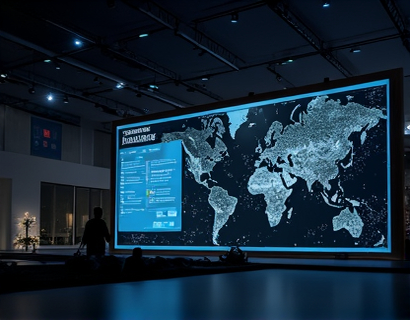Next-Gen QR Code Technology: Transforming Business and Social Media Engagement for Modern Enterprises
In the rapidly evolving digital landscape, businesses and social media managers are constantly seeking innovative solutions to enhance engagement and streamline interactions with their audience. One such technology that has emerged as a game-changer is next-generation QR code technology. This advanced form of QR codes is redefining how brands connect with consumers, offering customizable and intuitive tools that significantly improve information sharing and customer interaction. These next-gen QR codes are not just a simple upgrade from their predecessors but a comprehensive solution that aligns with the dynamic needs of modern enterprises.
The evolution of QR codes began with their introduction in the 1990s, primarily used for tracking products in manufacturing and logistics. Over the years, QR codes have expanded their applications to include marketing, advertising, and various other sectors. However, the original QR codes had limitations, such as fixed size, limited data capacity, and a static nature that did not cater to the evolving digital strategies of businesses. Next-generation QR codes address these limitations, offering a more versatile and powerful tool for digital engagement.
Enhanced Data Capacity and Flexibility
One of the most significant advancements in next-gen QR codes is their increased data capacity. Traditional QR codes can store up to 7,089 numeric characters or 4,296 alphanumeric characters, but next-gen QR codes can hold much more data. This enhanced capacity allows businesses to include detailed information such as comprehensive product descriptions, extensive contact details, and even multimedia content like videos and audio clips. The flexibility in data types also means that QR codes can be tailored to specific use cases, whether it's for e-commerce, event ticketing, or educational content.
Moreover, next-gen QR codes support various data formats, including URLs, text, URI, and binary data. This versatility ensures that businesses can integrate QR codes seamlessly into their digital strategies, whether they are promoting a new product, sharing a blog post, or providing a download link. The ability to embed rich and diverse content within a single QR code makes it an invaluable tool for enhancing user experience and engagement.
Customization and Brand Integration
Customization is a key feature of next-gen QR codes, allowing businesses to align these codes with their brand identity. Unlike standard QR codes that are typically black and white with a fixed shape, next-gen QR codes can be designed in various colors, shapes, and even logos. This level of customization not only makes QR codes more visually appealing but also helps in reinforcing brand recognition. Businesses can create QR codes that match their website’s color scheme, use their logo as the QR code design, or even create interactive and animated QR codes that capture attention and encourage interaction.
For instance, a fashion brand can design a QR code in the shape of a shoe or use their brand colors to make the code stand out on their product packaging or marketing materials. This personalized approach not only enhances the aesthetic appeal but also makes the QR code more memorable, increasing the likelihood of users scanning and engaging with the content behind it.
Improved User Experience and Accessibility
The user experience is a critical factor in the success of any digital tool, and next-gen QR codes excel in this area. These codes are designed to be more user-friendly, with features that enhance accessibility and ease of use. One such feature is the ability to generate QR codes with larger error correction capabilities. This means that even if the code is partially damaged or scanned from a distance, the information can still be accurately retrieved. This robustness ensures a smooth user experience, reducing frustration and increasing the chances of successful engagement.
Additionally, next-gen QR codes can be optimized for different devices and environments. They can be designed to be easily scannable on smartphones, tablets, and even smart glasses, ensuring compatibility across various platforms. This adaptability is crucial in a world where users access content through multiple devices, and businesses need to provide a consistent and seamless experience regardless of the device used.
Enhanced Tracking and Analytics
Tracking the performance of QR codes is essential for businesses to understand the effectiveness of their engagement strategies. Next-gen QR codes come with advanced tracking and analytics features that provide detailed insights into user interactions. These insights include the number of scans, geographic location of users, device type, and even the time spent viewing the content behind the QR code. This data is invaluable for businesses looking to optimize their marketing campaigns and improve customer engagement.
For example, a retail brand can use these analytics to identify which stores are generating the most interest in their QR code promotions, allowing them to focus their efforts on high-performing locations. Similarly, a tech company can track which products are most frequently accessed through QR codes on their website, helping them to refine their product offerings and marketing strategies based on consumer behavior.
Integration with Digital Platforms
Next-gen QR codes are not standalone tools but are designed to integrate seamlessly with various digital platforms and systems. This integration capability enhances the overall digital ecosystem of a business, making it easier to manage and execute engagement strategies. For instance, QR codes can be linked to social media profiles, e-commerce platforms, CRM systems, and content management systems. This interconnectedness ensures that user interactions are tracked and managed efficiently, providing a cohesive and streamlined experience.
Consider a scenario where a travel agency uses QR codes on their brochures to direct customers to a booking page on their website. By integrating the QR code with their CRM system, the agency can capture customer information and preferences, allowing for personalized follow-up communications and targeted marketing efforts. This level of integration not only simplifies the user journey but also enhances the business's ability to build lasting relationships with customers.
Security and Trust
In an era where data security and privacy are paramount, next-gen QR codes incorporate advanced security features to ensure that user information is protected. These codes can be encrypted, making it difficult for unauthorized parties to access the data they contain. This encryption adds a layer of trust, reassuring users that their information is safe when they interact with QR codes. For businesses, this means that they can confidently use QR codes for sensitive information such as financial transactions or personal data collection, without compromising user trust.
Furthermore, the use of secure QR codes can help combat fraud and counterfeiting, which are significant concerns in industries like travel and hospitality. By ensuring that QR codes are authentic and secure, businesses can provide a safer and more reliable experience for their customers, further enhancing their reputation and customer loyalty.
Case Studies and Real-World Applications
To better understand the impact of next-gen QR code technology, let's explore some real-world applications across different industries.
In the retail sector, a major clothing brand implemented next-gen QR codes on their product tags. These QR codes, designed with the brand’s logo and in their signature colors, link to a dedicated product page on the brand’s website. When customers scan the code, they are not only directed to detailed product information but also offered personalized recommendations based on their previous purchases. This integration has led to a significant increase in online sales and customer engagement, as users are more likely to explore and purchase products after scanning the QR code.
In the event industry, a conference organizer used next-gen QR codes for attendee registration and badge printing. The QR codes were linked to a digital registration portal, where attendees could check-in, access the event schedule, and connect with other participants. The use of QR codes streamlined the registration process, reduced lines, and provided attendees with a seamless and tech-savvy experience. The organizers also used analytics to track attendance patterns and gather feedback, which helped them improve future events.
In the healthcare sector, a hospital chain adopted next-gen QR codes for patient check-in and information retrieval. Patients received a QR code via email or SMS, which they could scan upon arrival to access their medical records, appointment details, and facility maps. This not only expedited the check-in process but also ensured that patients had easy access to important information, enhancing their overall experience and satisfaction.
Future Trends and Innovations
The future of next-gen QR code technology is promising, with ongoing innovations set to further enhance their capabilities and applications. One area of development is the integration of augmented reality (AR) with QR codes. By scanning a QR code, users can trigger AR experiences that overlay digital content onto the real world. This technology has vast potential in areas such as retail, where customers can see how furniture would look in their home, or in education, where interactive learning experiences can be created.
Another trend is the incorporation of blockchain technology to ensure the authenticity and security of QR code data. By using blockchain, businesses can create tamper-proof QR codes that provide a high level of trust and security. This is particularly relevant for industries dealing with high-value transactions or sensitive information.
Additionally, the development of smart QR codes that can adapt to different contexts and environments is on the horizon. These smart codes could change their content based on user location, time of day, or other environmental factors, providing a more dynamic and context-aware user experience.
Conclusion
Next-gen QR code technology represents a significant leap forward in digital engagement tools for modern enterprises. With their enhanced data capacity, customization options, improved user experience, advanced tracking capabilities, seamless integration with digital platforms, and robust security features, these codes offer a comprehensive solution for businesses looking to enhance their online presence and customer interactions. As the digital landscape continues to evolve, next-gen QR codes will play an increasingly vital role in helping businesses stay competitive and connected with their audience.










































